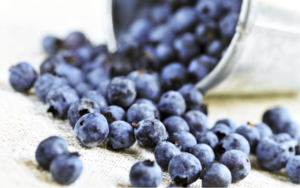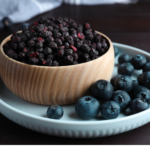Canned Blueberries: Benefits and Versatile Uses in Your Daily Diet
Canned blueberries offer a convenient and flavorful way to enjoy one of nature’s healthiest fruits year-round. As a bountiful source of vitamins, dietary fiber, and antioxidants, blueberries can contribute to a well-rounded diet. The preservation process retains many of the nutritional benefits, making it ideal for those looking to maintain a healthy lifestyle without compromising on taste or quality.

With my experience and research, I understand that proper canning methods are crucial to ensure the long-term storage and safety of canned blueberries. Whether incorporated into baked goods, used as a topping, or savored straight from the jar, these preserved gems add depth and nutrition to various recipes. Canning not only extends the shelf life but also locks in the blueberries’ natural sweetness and health benefits, offering a delightful mix of convenience and nourishment.
Key Takeaways
- Canned blueberries are a nutritious addition to a balanced diet, rich in dietary fiber and antioxidants.
- Understanding the canning process is key to preserving their nutritional value and flavor.
- Proper storage extends the shelf life, making blueberries accessible any season for culinary use.
Understanding the Canning Process

In canning blueberries, I ensure that I select the best fruit, use the proper equipment, and follow the necessary preparation steps. Mastery of these elements is crucial for a successful preservation.
Selecting the Right Blueberries
I look for fresh, plump, and firm blueberries with a deep blue color and a natural shimmery bloom. I avoid any that are bruised or soft, as damaged blueberries can compromise the quality of the canned product.
Essential Canning Equipment
The essential equipment for canning blueberries includes:
- Canning jars: I use glass jars free from cracks and chipping.
- Lids and rings: Essential for creating an airtight seal.
- Canning funnel: Helps in packing blueberries without mess.
- Water bath canner: A large pot with a rack, used to process jars.
- Jar lifter: For safely removing hot jars from the canner.
Preparation Steps Before Canning
Before I begin canning, I get my preparation done:
- Washing: I thoroughly rinse the blueberries under cold water.
- Sterilizing: Jars and lids are sterilized in boiling water.
- Syrup: If desired, I prepare a syrup—light, heavy, or extra light—depending on how sweet I want the canned blueberries to be.
- Filling Jars: Using the canning funnel, I pack blueberries into the jars up to the recommended headspace and cover them with the syrup.
- Removing Air Bubbles: A non-metallic spatula helps me release trapped air bubbles.
- Wiping Rims: I ensure the jar rims are clean before positioning the lids.
- Processing: The filled jars go into the water bath canner where they’re processed for the recommended time, which varies by altitude.
Types of Canning Methods
When it comes to preserving blueberries, choosing the right canning method is pivotal to ensure food safety and quality. Both water bath canning and pressure canning can be effective, and the choice between raw-pack and hot-pack methods will affect texture and flavor.
Water Bath Canning
I use water bath canning primarily for high-acid foods including blueberries. In this method, I fill canning jars with prepared fruit and seal them with lids and rings. I then submerge the jars in a water canner, ensuring the water level is at least 1 inch above the jars. As an example, the hot syrup method describes filling jars with hot syrup before processing. The processing time commonly lasts for 15 minutes for both pints and quarts. However, at higher altitudes, I adjust the processing time to achieve proper sterilization.
Pressure Canning
Pressure canning is a technique I opt for when canning low-acid foods, but it’s also suitable for fruits like blueberries when I want to retain their texture better. Unlike water bath canning, pressure canning employs steam under high pressure to achieve higher temperatures. I follow the manufacturer’s instructions closely for my specific pressure canner model, as processing times and pressures might differ. Although not always necessary for blueberries, this method comes in handy when I’m aiming for a longer shelf-life or dealing with diverse produce.
Raw-Pack vs. Hot-Pack
Raw-Pack Method: I prefer the raw-pack method when I aim to preserve the fresh flavor of blueberries. I pack the raw berries into jars and pour boiling water or syrup over them. This is a quicker process but can result in more floating fruit and potentially less flavor infusion from the syrup or water.
Hot-Pack Method: On the contrary, with the hot-pack method, I first simmer blueberries in syrup before packing them into jars. This pre-cooking process allows for better flavor infusion and reduces the chances of fruit floating in the jars. Although this takes additional cooking time, I find that it generally provides a better quality product, with a reduced risk of spoilage.
Canned Blueberries in Recipes

Canned blueberries offer a convenient option for adding a burst of blueberry flavor to various dishes, from baked goods to breakfast foods. Let’s explore the versatility of canned blueberries in different culinary contexts.
Baking with Canned Blueberries
When I bake with canned blueberries, my kitchen is filled with the aroma of sweet treats in the making. Canned blueberries are excellent in baking because they’re already soft, sweetened, and full of flavor. I use them in creating moist and delicious blueberry muffins, ensuring an even distribution of fruit in every bite. They are also a hassle-free addition to cakes and pies, providing a rich blueberry taste without the need for washing and sorting fresh fruit.
- Muffins/Cakes: Fold canned blueberries into the batter as the last step before baking to avoid color bleeding.
- Pies: Canned blueberries serve as a ready-to-use pie filling, especially when mixed with thickening agents like cornstarch.
Sauces and Toppings
Canned blueberries are not just for baking; they also make remarkable sauces and toppings. I often craft a quick and easy blueberry sauce to drizzle over pancakes or swirl into Greek yogurt. For a decadent treat, I mix canned blueberries into a homemade sauce that can be poured over ice cream or cheesecake, creating a delightful contrast of flavors and textures.
- Sauce Base: Puree canned blueberries with a sweetener and lemon juice for a tangy and sweet sauce.
- Toppings: Whole canned blueberries can be used as toppings for desserts or mixed into oatmeal.
Breakfast Combinations
I believe that starting my day with a healthy breakfast is essential, and canned blueberries make it easy to enhance my morning meals. They’re a comfortable addition to yogurt parfaits or cereal, turning ordinary breakfast into something special. Complementing them with grains like granola adds a satisfying crunch, while a dollop of blueberry syrup can elevate a stack of fluffy pancakes or waffles.
- Parfaits: Alternate layers of yogurt with canned blueberries and granola for a textured and nutritious breakfast option.
- Syrup: Blend canned blueberries into a syrup to top French toast or oatmeal.
Preserving Nutritional Value

When canning blueberries, it’s important to keep as much of their nutritional value intact as possible. I’ll explore the specific contents of canned blueberries, focusing on their sugar and sodium content, and how they compare nutritionally to fresh blueberries.
Nutrition Comparison
Canned blueberries often retain most of the vitamins, antioxidants, and minerals found in fresh blueberries, including vitamin C, vitamin K, and manganese. Despite the canning process involving heat, which can reduce certain heat-sensitive nutrients, canned blueberries are still a valuable source of dietary fiber and antioxidants that can support a healthy diet.
- Vitamin C: Essential for immune function and skin health.
- Vitamin K: Important for normal blood clotting and bone health.
- Manganese: Plays a role in bone development and various body enzyme functions.
- Dietary Fiber: Aids in digestion and can help maintain blood sugar levels.
- Antioxidants: Blueberries are high in antioxidants which may reduce the risk of chronic diseases.
Sugar and Sodium Content
When canning blueberries, a common practice is to add syrup or liquid to preserve texture and taste. This can increase the sugar content in the final product. Some preparations use alternatives like honey to sweeten the blueberries, which can offer a nuanced flavor profile and possibly retain more nutritional benefits.
As for sodium, it is typically low in canned blueberries unless added for preservation. It’s key to read labels carefully or can your own blueberries to control sodium intake.
- Sugar: Watch for added sugar in syrups or consider using honey as a natural sweetener which may offer additional benefits.
- Sodium: Generally low, but always check labels if you’re monitoring your sodium intake.
Storage and Shelf Life

Canned blueberries offer a convenient way to enjoy this fruit outside its season. When handled and stored correctly, they can last for quite some time, ensuring that these preserves remain safe to eat and flavorful.
Proper Canning Techniques and Storage
When I can blueberries, I always use a waterbath canner for proper processing. This method is suitable for most high-acid fruits, including canned blueberries, canning blackberries, and canning strawberries. Here’s a quick rundown of the steps I follow:
- Prepare the Blueberries: Wash the fruit thoroughly.
- Sterilize Jars and Lids: Boil them in water for at least 10 minutes.
- Fill Jars: Pack blueberries tightly, leaving proper headspace.
- Clean the Rims: This ensures a secure seal.
- Process: Place jars in the waterbath canner and cover with water.
- Adjust for Altitude: Increase processing time as needed based on your altitude.
Storing the canned blueberries in a cool, dark place can significantly extend their shelf life. Typically, the canned blueberries I store this way last for about 12-18 months without significant loss of quality.
Assessing Canned Blueberries for Spoilage
Over time, even well-canned goods can spoil. I regularly check my canned goods for signs of spoilage, which include:
- Bulging Lids: Indicates potential bacterial growth.
- Cloudy Liquid: Could be a sign of spoilage, especially if accompanied by off odors.
- Off Smells: Follow your nose; if something smells wrong, it’s best to err on the side of caution and discard.
Any canned blueberries showing these signs should not be eaten and must be discarded immediately. Freezing is another option to extend the blueberries’ keeping quality even after opening, but the initial canning process is key to longevity.
Frequently Asked Questions
In this section, I cover common inquiries about canned blueberries, from culinary uses to nutritional comparisons, purchase options, preservation mediums, top brands, and health benefits associated with these preserved fruits.
What recipes can you make with canned blueberries?
You can create a variety of recipes with canned blueberries, such as pies, muffins, and sauces. Since they’re pre-cooked in the canning process, they’re also convenient for quick dessert toppings or smoothies.
How does the nutritional content of canned blueberries compare to fresh?
Canned blueberries generally have a similar vitamin content to fresh blueberries, but the canning syrup or juice may increase the sugar content. The canning process might result in a slight reduction of water-soluble vitamins like vitamin C.
Where can I find canned blueberries available for purchase?
Canned blueberries are typically available at supermarkets, often found in the canned fruit section. They can also be purchased online from various retailers.
Are canned blueberries immersed in water, juice, or syrup?
Canned blueberries can be found immersed in different mediums—water, fruit juice, or light to heavy syrup. The choice depends on personal preference and dietary considerations.
What are the best-rated canned blueberries on the market?
The best-rated canned blueberries are those that maintain a good balance of flavor and texture without excessive added sugars. Brand preferences vary, so it helps to read reviews and try different products to find your favorite.
What are the health benefits of consuming canned blueberries?
Consuming canned blueberries can provide antioxidants and various nutrients like vitamin C and manganese. However, it’s important to consider the sugar content in syrup-packed options when consuming them for health benefits.


 Previous Post
Previous Post Next Post
Next Post